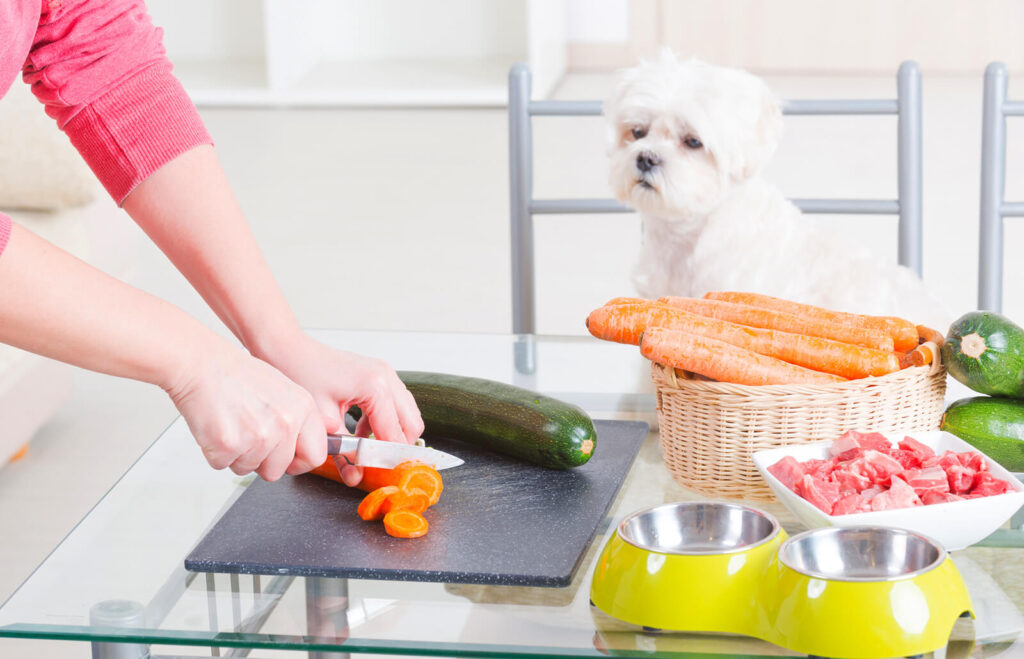
Sixty-seven percent, which equates to around 85 million families in the US, own pets. The pets are part of these families, and it is not strange to find a pet parent trying different treats to make their canine friends feel loved and part of the families.
To give the best to your pets, you could be wondering whether you should give it pet foods you make from home or buy these foods directly from a bakery. For most pet parents though, buying the dog foods from a dog bakery is convenient.
However, you may think that buying the treats from a dog bakery or store is a little costly compared to making them from home. You’re not alone.
Most pet parents assume the same. If you get down to the preparation process, sourcing ingredients, and then preserving these foods to serve you for an extended period, you’ll be surprised to discover that the store-bought pet foods are way much affordable compared to making yours from scratch.
To give you the bigger picture of these two options, we compare homemade dog treats vs. store/bakery bought dog treats. This comparison is based on what goes into the preparation process, the quality of these special foods, preservation, and the overall cost. We have also summarized two tables to help you compare both options.
Preparation

Store-sourced dog foods are ready for use. You won’t have to go through the hassles of preparing them again.
If you make the treats from home, you’ll need some time to prepare and make them ready for consumption. The primary difference, however, is bakery-bought treats are prepared under strict supervision.
Besides, they’re tested for quality before being released to the market. In contrast, if you make similar pet foods at home, you may not be sure about the right proportions to mix the ingredients used.
This implies that your final product may be over-concentrated with some nutrients than others. Either way, you may also mix lesser proportions of nutrients than are required.
Now the risk with a mistake like this is that your dog may get malnourished if you’re using the foods as a nutritional supplement, but the nutrients are imbalanced. On the same note, if you use more than the required amounts of starch and fatty ingredients, the pet may struggle with overweight issues even if you stick to the critical 10 percent rule.
The Quality

We all want the best qualities from the products that we purchase to use. Because of this, most consumers prefer products with marks of qualities to those that don’t have these marks.
This doesn’t mean that homemade dog foods are of minimal quality. The concern, however, is in the type of ingredients that you use to make these treats.
If you have experience making pet foods, perhaps from a bakery, you probably know a few tricks to discern inferior quality ingredients from good quality ones. If you don’t have any experience though, you may not even know how to test for the potency of the ingredients that you use.
Here’s another place where bakery-bought pet foods get the upper hand. If you buy the treats from a well-established doggie bakery where manufacturers use human-grade ingredients, you’ll be assured that all the ingredients used were safe and fresh. Tail Bangers is one such bakery you can trust when it comes to quality.
Preservation

First things first, even if you’re buying from a bakery, it would be better to stay away from chemically-preserved pet foods. Even though these chemicals would give your favorite doggie foods longer shelf life, they pose significant health hazards that could dangerously deteriorate your dog’s health.
Ethoxyquin, for example, is a very popular preservative used in the store-based treats. It is known to cause certain very disturbing forms of cancer in dogs like cancer of the liver. Therefore, an excellent bakery should not use these chemicals and let you know about this in advance.
If they use certain forms of preservatives, the basic rule of thumb is to use Tocopherols (Vitamin E) or Ascorbic acid (Vitamin C). These preservative alternatives are known to reduce rancidity in pet foods and still do no harm the pets unless the pet is allergic to them, which is also very rare.
Now, if you buy your treats from a bakery, they’ll be well-preserved, and you’re also made aware of the time frames when the dog food will be viable for use. If you make yours from home, though, you may not have a clear idea of using the preservatives or their degradation rates. This means that your treats may go rancid quickly before serving the intended purpose.
Cost

Pet foods sold in bakeries are usually priced based on the costs for producing them. These costs are structured to take care of aspects like the ingredients used, packages used, and any additional related selling fees.
On average, simple high-quality special dog foods will cost you anywhere between US$29 to US$63. They’re treats that would give you an excellent service for a reasonable duration so long as you store the remaining pieces well after opening the package. If you make the pet snacks from home, though, assembling just the ingredients alone from different suppliers could be time-consuming and costly.
Summary Pros and Cons of Store/Bakery Bought Dog Treats vs. Homemade Dog Treats
Store/ Bakery Bought Treats Pros and Cons

| Pros
|
Cons |
| Convenient. No preparation process needed Purchase and Serve. | Some manufacturers use filler ingredients. |
| Doesn’t have toxic additives that may be hazardous to your pooch.
|
May contain allergens that certain dogs could be sensitive to. |
| Prepared under strict regulations to ensure potency and safety.
|
Some manufacturers may also use chemical preservatives, so you’ll need to pay more attention to the ingredients before making the purchase. |
| Easy to serve. You know the ingredients content so you can easily calculate the right pieces/amounts to give your pet per day and maintain the 10 percent rule. | |
| Easy to store |
Homemade Dog Treats Pros and Cons

| Pros | Cons |
| You control everything that goes into the pet food. | Sourcing ingredients might be costly and time consuming. |
| No filler ingredient used. | There’s a risk of nutrient imbalance. |
| No preservative used | Time-consuming since you have to set aside specific times to prepare the pet foods. |
| You may have a lot of waste treats to dispose of if you make too much snacks for your pet. |
Bottom Line
Some pet parents may favor making treats from home since you control which type of ingredient goes in the preparation process. On the flip side, there is a risk of not mixing ingredients in the right proportions. It is also not convenient, especially if you have a busy schedule.








